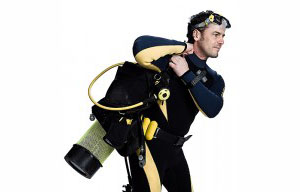 My fellow divers are some of the most enthusiastic people I’ve ever met. They are always looking for information and ways to help them improve as divers, and the fitness department is no exception. I repeatedly get asked about the best way to get in shape for diving to reduce gas consumption and be more efficient. Considering diving itself should not be physically strenuous and takes place in an environment where buoyancy changes how mechanical forces affect our bodies, the answer is not quite what they expect.
My fellow divers are some of the most enthusiastic people I’ve ever met. They are always looking for information and ways to help them improve as divers, and the fitness department is no exception. I repeatedly get asked about the best way to get in shape for diving to reduce gas consumption and be more efficient. Considering diving itself should not be physically strenuous and takes place in an environment where buoyancy changes how mechanical forces affect our bodies, the answer is not quite what they expect.
The key is to strengthen for on-land demands and understanding that skill development, confidence, and trim will have a much greater influence in gas consumption than exercise alone. Such an answer seems too simple to be effective and those who reject it will continue looking for the “better-diver-now” magic exercise.
And there are those who have never exercised yet somehow are convinced scuba diving is a great form of exercise. Again, considering how the hallmark of diving excellence means using the least amount of effort possible to extend gas consumption, I only see a contradiction.
So what is the best way to get in shape for diving? Seeing how there are many approaches all equally valid, it is impossible to say there is a “best” way. It will benefit the diver to practice and excel in as many approaches as possible to give the body novel stimulus, prevent overuse, avoid burnout, and keep the mind-body connection active.
I write this article with the cold water diver in mind. If fitness is important for all divers, it is even more important, if not crucial, for the cold water diver. Cold water divers face harsher environments and unpredictability making the need for a body fit to withstand stresses even more important. Finally, being a cold water diver myself, it is an environment close to my heart with many amazing divers who I respect and from whom I’ve learned much.
So what makes physical fitness more crucial for the cold water diver? Consider the following factors.
Cold Water and the Body
 When getting in shape, divers rarely think of the physical responses occurring as a result of exposure to the cold. Cold water immersion is usually perceived as a threat and unleashes a series of physiological responses.
When getting in shape, divers rarely think of the physical responses occurring as a result of exposure to the cold. Cold water immersion is usually perceived as a threat and unleashes a series of physiological responses.
Do you remember how disconcerting it felt the first time you immersed your face in cold water? Sure, you had a exposure suit, boots, and gloves, but that bit of exposed skin in the face felt the shock. It is what most first time cold water divers experience as their faces get enclosed in the cold element. This automatic panic response can pose a significant physical challenge producing increased heart rate, tachypnea, decreased core circulation, and tense jerky motions.
The extent of the physical response is so tremendous, a significant number of fatalities, immediate or during the dive, are attributed to it.
Physically fit bodies have a better chance of withstanding the physical rigors of the panic response, but let’s not neglect the importance of skill. All the strength training in the world cannot substitute skill development and confidence. The combination of physical fitness and skill will allow the diver to extricate a buddy in distress, engage in emergency swimming, or simply dealing with the on-land demands like hauling heavy gear.
The Gear and its Physical Implications
Divers in the warmer environments have the advantage of lighter configurations of gear. A warm water diver in minimalist gear can splash donning nothing more than:
- A pair of swimming trunks
- Fins
- BCD
- Ballast
- Aluminum tank
Those diving in the plankton-rich, cooler environments need to carry more gear for their explorations. A cold water diver even in minimalist gear usually dons:
- Drysuit with undergarments or heavy 7mm suit
- Heavy Fins (some ankle weights) to counteract suit buoyancy
- Steel or aluminum backplate
- Heavier Ballast to counteract suit buoyancy
- Steel tanks (frequently doubles)
- Thick boots
- Thick Gloves
- High Power Lights
The gear alone can easily reach over 50 pounds, with redundancy for safety or technical dives requiring additional bottles, scooters, tools and rigs, the 100 pound mark is easily surpassed. Yes, the equipment is kept close to minimize its drag in the water and making it more bearable on land, but there is no denying it requires a significant level of strength to be comfortable and efficient with it.
